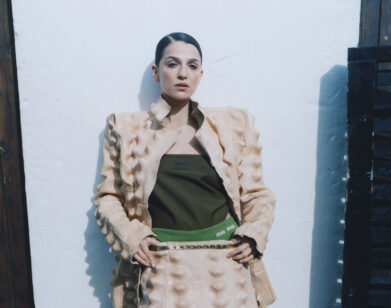How Jillian Mayer Made YouTube Art

JILLIAN MAYER. PHOTO COURTESY OF LUCAS LEYVA.
Last week, the walls and rotunda inside the Guggenheim were splashed with a number of the top 25 selections for the first-ever “YouTube Play: A Creative Video Biennial.” Billed as a milestone for the vid-sharing web behemoth, the exhibited shorts were chosen by celebrated jurors that included Darren Aronofsky, Ryan McGinley and (semi-recent Guggenheim appointees) Animal Collective, from an open call this summer that topped 20,000 international submissions. In the days since, The New York Times has stirred a mini-controversy, suggesting that the presentation and selections failed to capitalize on or refer to the oft-zany power, however accidental, and unabashed outsider populism of the medium. It’s both to the jury’s credit and to its handicap that among the highlighted entries—which averaged under five minutes in length—not one featured groin-shot laffs or the puppy-eyed hysterics that make the website a mindless sanctuary from mindless office droning.
“The [Times] article seemed surprised that videos submitted by amateur and professional filmmakers would rise to the top,” said Jillian Mayer, a twentysomething performance artist who was flown in from Miami to attend the event after her video made the final cut. “It almost seemed like the writer thought filmmakers didn’t deserve to take spots away from videos sent in by, I dunno, doctors—which is bullshit.” Mayer’s video, “Scenic Jogging,” is just over a minute in length and features her sprinting down a desolate Miami street at night, racing to keep up with naturalistic imagery projected onto passing buildings. Unlike most YouTube clips, it’s hard to explain the appeal of “Scenic Jogging” in less time than the clip itself. This weekend, we talked with Mayer about how she came to participate in YouTube Play, and the state of art and culture in her native Miami.
HUNTER STEPHENSON: How did you initially find out about YouTube Play? And how were you notified that your video had been selected from over 23,000 submissions?
JILLIAN MAYER: I work with Lucas Leyva of the Borscht Film Festival in Miami, and he informed me about the contest and encouraged me to enter. And we work together a lot. We’re working on a short film in Miami now, where we live, and we have another in the planning stages. A little over a month before the Guggenheim event, I received an email that I had been selected. It was confidential at the time, but I was told the video had qualified for both the top 125 and that it was one of the 25 final selections. And the actual presentation at the Guggenheim, it was much more extravagant than I had expected. We equated it to the Video Music Awards. [LAUGHS] Seeing the film projected on the rotunda was cool, and from New York, the video goes to the Guggenheims in Berlin, Bilbao, and Venice. There is a Guggenheim in Abu Dhabi too, but they are not participating. I don’t think they have YouTube.
STEPHENSON: Why do you think “Scenic Jogging” stood out and spoke to the jurors at YouTube Play?
MAYER: Whenever you enter a technology-based contest, I think it’s safe to believe a number of the entries will be incredibly technical. So I decided to focus on a basic concept, one idea that was really strong, almost as an alternative. And I chose to work with a green screen because it was rudimentary. I think the end result is as much about the creation of the imagery as the imagery itself. And I knew—well, I visualized—that people would be watching the video sitting down, or standing around at an event or mingling at a party. So, I wanted the video to be both an expression of movement and exertion, and a documentation of it. If that makes sense.
STEPHENSON: One observation about your video is that it juxtaposes a dull cityscape at night with a bright rush of nature imagery. And this contrast between nature and concrete is often attributed to Miami…
MAYER: Yeah. And for the nature imagery, I specifically chose to jog against nature screensavers made for computers. It’s common for a city dweller to desire nature. There’s a primal desire inside to be outside, or to be outside of a cubicle and away from the office. And to me, “Scenic Jogging” is also a comment on how screensaver images are chosen, how for years they have played into office escapism. I’ve always wondered if the designer, or the engineer—whoever is responsible for those images being on your computer—thinks those images are simply nice, or believes they appeal to all people. Or, if the person finds them absurd or funny, and is aware of their kitsch. And there’s the idea that you walk through a forest to enter your mundane work files. But the screensavers aren’t snapshots of forests, the images are themselves made on computers, or enhanced by them. Nature has to be beefed up. So, when I’m running against these images in the video, it’s like, even if I reach the imagery or become a part of it, even if I’m quick enough, it’s futile. Those places do not exist. It’s kinda sad. [LAUGHS] And it’s different from a lot of my work, I should say that. My work tends to have more of a comedy element. My friends and I decided that “Scenic Jogging” has a more serious tone because it was shot at night.
STEPHENSON: Right. A young girl running down an empty city street at night, it has a certain predatory aspect…
MAYER: Yeah. I could be running from a rapist… or I could be running from cheesy people in Miami, or Snooki from Jersey Shore. [LAUGHS] I would say I’m inspired by a few of Miranda July’s projects and by Sarah Silverman. She likes to combine her sense of humor with a physicality that’s not entirely sexual. And it’s practically a given, but Yoko Ono’s Grapefruit book is a big influence on me as well.
STEPHENSON: In the presentation at the Guggenheim, I noticed that your pet was featured. And it seems to play a muse-like role in your life and work.
MAYER: I think having an animal in your house is a great way to encourage imagination. You have invited an animal to come live with you, and it changes the dynamic and affects your personality. And personally, I invited a Chihuahua to live with me some time ago, a Chihuahua named Shivers. Shivers is always there with me. Casting her in my work, it just seems like the best thing to do no matter what. [LAUGHS] She is a very curious animal and unlike people, she does not object to ideas or make judgments about what is art. Food? That’s different. I would say Shivers has become a second conscience for me in my work.
STEPHENSON: Okay. [LAUGHS] Do you think incorporating a pet into your performance art and video projects lends itself to the Internet’s never-ending obsession with small animals?
MAYER: I think it’s connected to that trend, sure. This may be why people respond strongly to Shivers in my work. But I don’t think the Internet has made puppies any cuter. I think puppies have been cute from day one and now they are getting the cute recognition they deserve. I am also fascinated by how celebrities’ pets, for a while at least, they were getting smaller and smaller in the tabloids. And cuter and cuter until they were no longer cute. They were gross. Like little gremlins. Shivers is sort of like that. She has lost a few teeth on one side of her mouth as she’s gotten older. So, only one side of her face is cute now. I like to call her Harvey Dent.
STEPHENSON: What is going on right now in Miami, as far as youth culture and film, that people should look out for online or if they visit?
MAYER: There are a lot of interesting subcultures in Miami that are surfacing, but that has been the case for years. The difference now is that funding is becoming more available, and the more experimental, younger artists, the city’s older art community is beginning to pay attention. Without help from the Knight Foundation, a lot of what is happening might not be. We really need a platform to reach new audiences beyond the young people involved there. Sweat Records is the indie hub of Downtown, and as I mentioned, there’s the Borscht Film Festival, which develops and promotes the work of young filmmakers. Local filmmakers are so important, because Miami is still defined by Miami Vice, and whatever imagery MTV pumps out. And there is also Morphologic Studios. What’s great about them, they are facing the same dilemma and hesitation from art galleries here that video art faced the previous decade. They study marine biology and cloning, and present organisms—um, sea critters, to be technical—in the context of art and visual aesthetics. Miami’s culture is still snagged in a weird limbo between new and old, and now marine biologists have slithered their way into it. [LAUGHS]
CLICK HERE FOR MORE INFO ON YOUTUBE PLAY. FOR MORE INFO ON JILLIAN MAYER, VISIT HER WEBSITE. SHE IS CURRENTLY REPRESENTED BY DAVID CASTILLO GALLERY.






